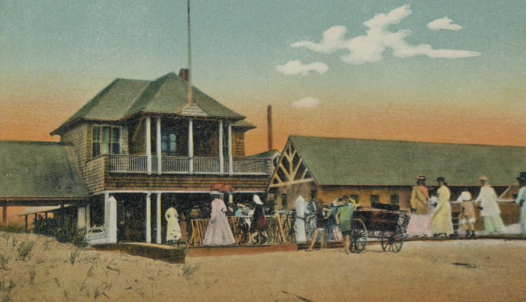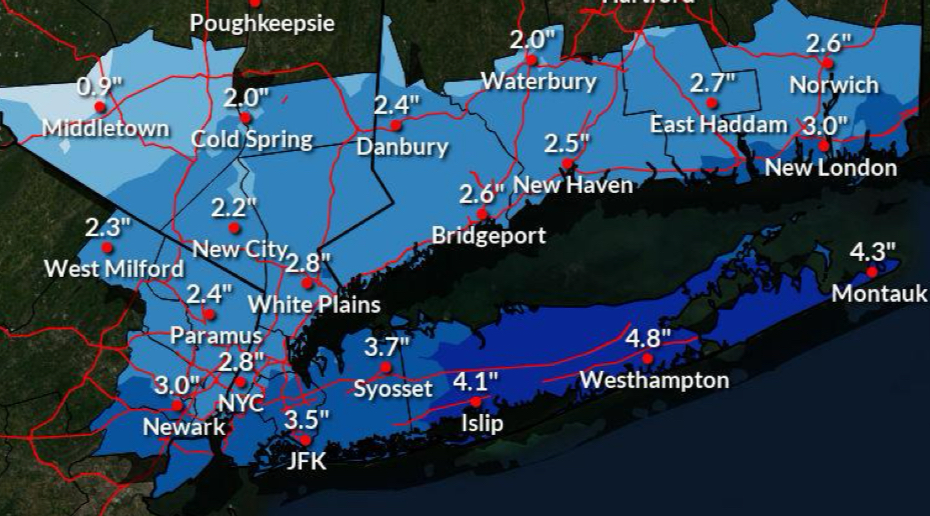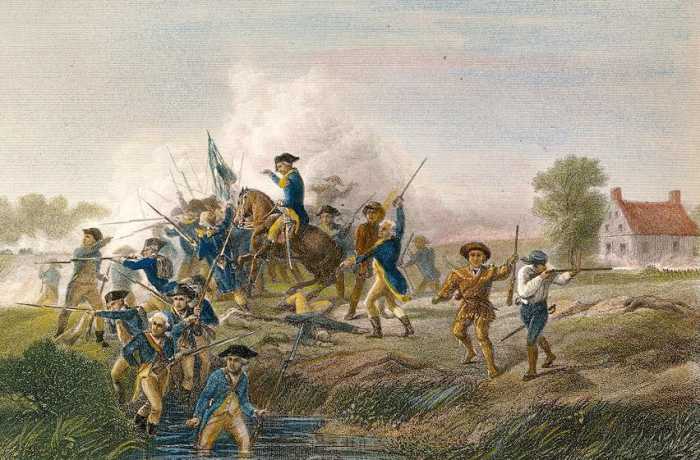Our Crowd Arrives: When The First Summer People Came To Southampton In The 1870s

In September of 1863, a young Manhattan physician of means by the name of Theodore Gaillard Thomas went by horse and wagon out to visit the farms and rural villages of Long Island with his wife.
The trip lasted many days. The couple spent their first two nights in Babylon staying at a rooming house, then pressed on to Quogue, Southampton, East Hampton and Montauk, finally spending a night out at the lighthouse with the keeper and his family there.
During this sojourn, Thomas fell in love with the simple, bucolic communities of eastern Long Island and, after returning to Manhattan, vowed that sometime in the future he would return with some friends with the intention of establishing a summer colony there. He had become charmed by the farmland that went down to the ocean, the single Main Streets with the Presbyterian churches, the blacksmith shops, feed stores and dry goods stores that marked what were essentially old New England communities. He did take note of a small summer colony of well-to-do Brooklyn fishermen in Quogue when he spent the night there, but there was nothing further east.
Thirteen years later, in 1876, Dr. Thomas and his family returned to Southampton, just six years after the Long Island Railroad service had built tracks out to that town, (and then on to Bridgehampton and Sag Harbor.) Still finding it as peaceful and unaffected as it had been all those years before, he decided he would buy some property and build a mansion for his family down near the ocean. Also, as he was quite connected with the social set in Manhattan at that time, he thought to invite as many friends as possible to come visit him and, if they wanted to, also build homes there.
Dr. Thomas is considered to have been the founder of the Southampton Summer Colony as we know it today. Within four years, he had persuaded many others to build there. By 1880, there were 30 summer mansions where five years earlier there had been none. A year later, Dr. Thomas and others in that group met in a Fifth Avenue apartment in Manhattan to found what was then called the Southampton Village Improvement Association (SVIA) to “beautify the principal streets” and “see to the removal of nuisances” so as to make Southampton even more attractive to possible future summer residents. They lined both sides of Main Street with 190 trees. They induced a dry goods merchant to clean up his yard. They put up $25 to get a man who ran an unsightly blacksmith shop to move it to a side street. And he and his friends made it a goal to have the community pick up after itself. “It is earnestly hoped,” they wrote in the minutes of one of their meetings, “that especial care will be taken to keep rubbish, paper, straw, old cans and all kinds of litter out of the road.” As you might have imagined, they soon came into conflict with the local residents of the community—there were about 500 of them, who were enjoying the town as their ancestors had for 200 years before—farming the land, fishing the waters and otherwise engaging successfully in rural activities.
Sparks flew. Nevertheless, within the next 15 years, Dr. Thomas and the others saw to the creation of just about all the major downtown Southampton institutions we have today, including the St. Andrews Dune Church, the Shinnecock Golf Club, the Meadow Club, the Southampton Beach Club, The Parrish Art Museum and much else. They built their mansions not only down on the ocean but on all sides of Village Pond, which they renamed Lake Agawam, letting it be known that this was their private jewel, their summer centerpiece, which they would take care of and attend to without interference. “Not a weed or leaf that floats on its surface escapes our notice” the new president of the Association, Salon Wales, told the membership at one meeting. “We should watch it as we would a precious jewel.”
At the time of all this, at least early on, they could do all this because there was not yet a municipality called Southampton Village. Downtown Southampton was simply part of the larger municipality of Southampton Town, which extended from Sagaponack to Westhampton. The Town had only a small interest in the doings in downtown Southampton. And so at least until 1894 when the village was finally formed, there was no formal structure among the locals to defend their way of life.
Nevertheless, just four years after the formation of the Southampton Village Improvement Association, there took place a legal battle ending in a sensational trial which pitted the locals versus the summer people over the ownership of the beachfront in that community, and whether the summer people even owned the land upon which many of their houses were built. It rocked the community. And it formed the basis of who owns what and who can do what today in a three-mile stretch of beach from Old Town Road to Ox Pasture Road along the ocean.
I have always been interested in the founding of our communities. I have learned of all the above and more reading a book published last year by SUNY Press, written by David Goddard, entitled Colonizing Southampton. Dr. Goddard is an academic, a retired professor of Sociology formerly at the City University of New York. He too became fascinated with the early history of this summer colony, came here a few years ago to go through many old documents, including the local paper The Seaside Times from that era (The Press had not yet been founded), then moved to Plattsburg, New York to write the story. (The parts in quotes in this account are from his research.) It is an amazing tale.
If Dr. Thomas founded the Southampton Summer Colony, his efforts were soon overshadowed by other New Yorkers far richer than he who bought up property from the locals to create lots for others to build their summer cottages. Among them were Charles Atterbury, James Ruggles, Mrs. Wm. Schemerhorn and two brothers, Wyllys and Frederic Betts. Some of them had big plans for the town—for instance Wyllys for a time had plans to build a casino and beach hotel in town.
The land made available to the city people was largely from a group who called themselves the Proprietors, wealthy local people who in common, as a group, had inherited much of the land from their ancestors, the original founders of the community. There were farmers and merchants who owned land separately of course. But what had not been divided up by that time was still in the hands of the proprietors. And they were willing to sell parcels to the new summer people for $200 a lot at first, then $300 and on up to $500 and $600. One summer person wrote a letter to The Seaside Times, grousing about it. “The rapacity of the landowners of your village,” he wrote, “(can only induce) irretrievable ruin (if they persist in such) absurd pretensions.” Eventually, they pretty much sold all they had to the new summer community. That is what accounted for this three-mile stretch along the beach and around the Lake, a group of homes owned by city people out for the summer to stroll on the beach, take an afternoon sunbathing in the dunes and otherwise take to what was believed was the healthy rural “air.”
The locals did not at first know what to make of the summer people. They were surely of an entirely different culture from the locals. The locals soon gave a knickname to these interlopers. They called them “Yorkers.” But they tolerated them because they had to. And they also profited from them.
At the time of Dr. Thomas’ arrival, the beaches along that three-mile stretch were largely considered part of the industry of the community. Whales were brought ashore on the beaches. Fishermen dragged nets in. Perhaps most important, the beach was considered a road. Carts with wide wooden wheels plied the beaches, taking people and merchandise from one village to another between East Hampton and Westhampton. The sand, particularly at low tide, was hard and smooth. It was far easier to use the straight line of the beach highway than to travel by wagon along the rutted main road inland. The locals didn’t even call the mounds of sand at the back of the beaches “dunes.” They called them “banks.” And indeed they were. They were one of the lifelines of the prosperity of the community.
The locals dressed in simple rural attire, of course. And they did take time out for beach bathing. At one particular location, near to where the Southampton Bathing Association is today, they had established a group of beach shacks, which they called “wigwams,” where people could change into bathing suits and from there go for a swim.
The summer people, of course, did call the sand at the back of the beach “dunes,” a far more romantic term. And one day, a summer resident named Willy Betts, having built his beachfront mansion on the dunes—much too close to the sea as the locals saw it—went out with a crew and tore down all the wigwams. They had been blocking his view. Furthermore, the locals went bathing in scandalous beachwear, something this man did not want his family to have to look at. At the time, the women in the social set wore beach attire that covered practically their entire bodies.
That act—and fences went up and the wigwams could not be put back up—was quite possibly what led to the legal challenge that resulted in a trial beginning in 1885 about who owned the beach. The locals said they did. The summer people said they’d bought it fair and square. It went to court.
Leading the charge for the locals was George B. White, a farmer, a former whaling captain, and now, the leader of the Town Trustees. A few years earlier, he had successfully led a fight against the Proprietors of Southampton over who owned Mecox Bay. The Proprietors had, because of their vast land holdings, taken to “selling” various ponds and lakes within Southampton Town, in the belief that because they owned the land surrounding them, they could sell the ponds too. The Proprietors had earlier sold Poxabogue Pond (for 35 pounds), and they had sold Otter Pond in Sag Harbor (for a similar amount.) Now the proprietors wanted to sell Mecox Bay, to a New York City oyster company (represented by summer resident Richard Esterbrook) to fish its bottom to the exclusion of everybody else.
White had taken on the oyster company, saying they were there illegally because the town in common, meaning all the citizens, owned the pond, as a result of a group of early English patents that later, after the country was founded, brought all the waters to town ownership in the aftermath of the Revolution. And he’d won. Now he challenged Frederic Betts, a member of the Southampton Village Improvement Association, who had claimed ownership of all the ocean beaches fronting his property and had begun fencing it off.
In the end, a judge ruled that the Betts purchase had included the beach in front of his house down to the high water mark because the land he bought from the Proprietors had included that. Below that, to the low water mark, the locals could haul their fish and have free passage. He also ruled that various roads down to the beach could be pathways to the beach for the locals.
Although this was a compromise, it was a great disappointment for the locals as they felt they had lost what had been theirs up until then. And it marked the formalization of the exclusive nature of the Southampton Summer Colony as we know it to this day.
Author Goddard draws charming descriptions of the people and their behavior of that time. He describes how the summer people, when they formed their Southampton Village Improvement Association, also included some prominent local farmers and merchants—without even telling them in advance they were doing so. The summer people felt by doing this, they were getting broad representation. Of course none of these prominent locals were on the executive committee that made all the decisions.
The SVIA also gave an honorary membership to the SVIA to Walter Burling, the publisher of The Seaside Times. They got good press after that.
Goddard describes the financial crisis of 1873, when Jay Cooke and Company collapsed on Wall Street after failing to sell Northern Pacific Railroad Bonds. This crisis lasted through to 1895, and the rich of New York, looking for places to put their money safely, saw Southampton real estate as one of those places. Thus was the founding of the summer colony hastened.
Goddard also describes the one group that the SVIA could not defeat. That was the Long Island Railroad. As part of the SVIA’s efforts to beautify Southampton (they included wooden road signs designed in a way that would make an antiquarian proud), they had approached the railroad hoping to get them to build a railroad station the community would be proud of rather than just the old existing shack. They never did get them to do it, and around 1902, had to pay much of the cost themselves to get the beautiful station with the embedded seashells in it you see there today.









